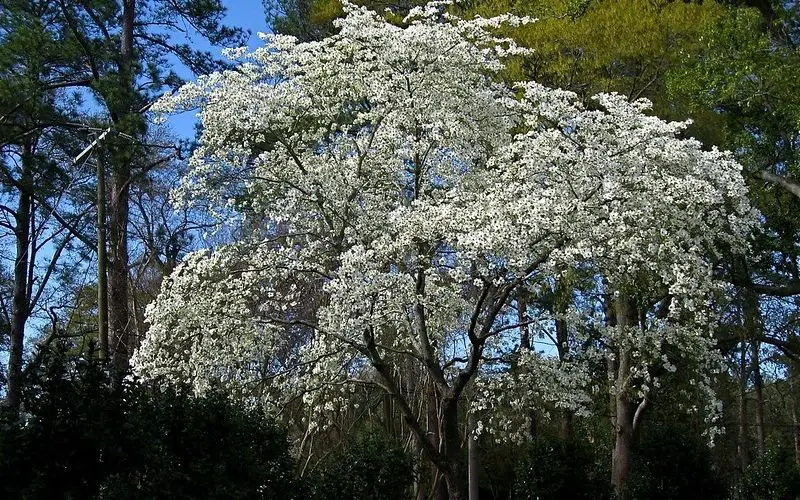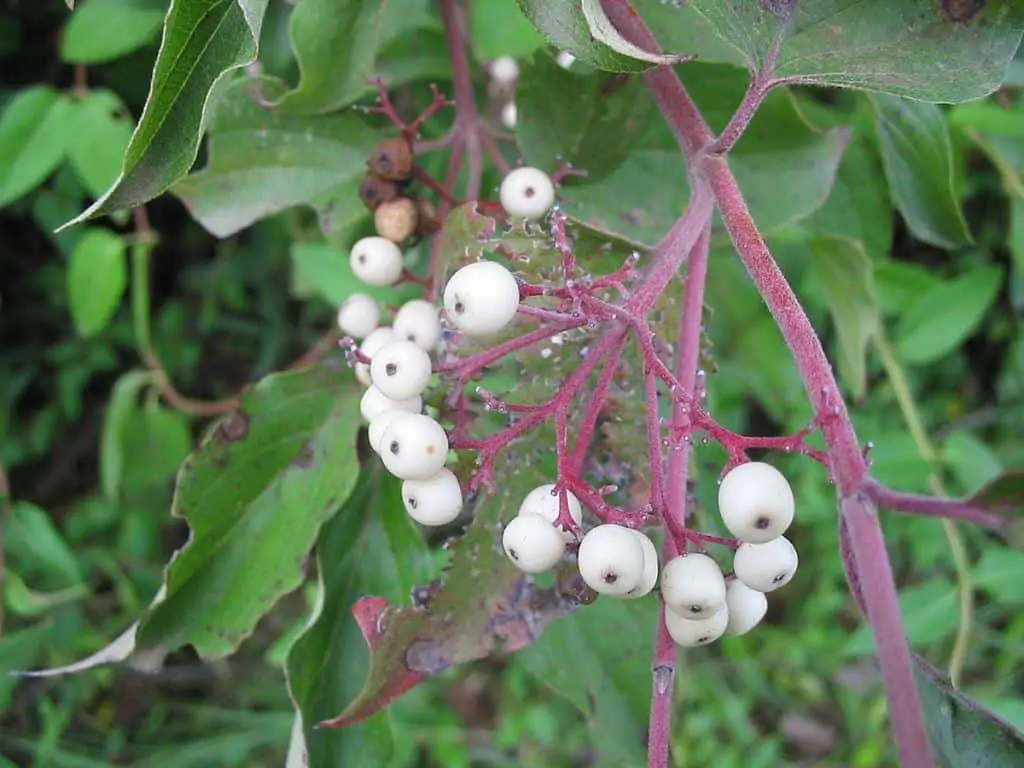Gray Dogwood is a beautiful flowering Shrub. The botanical name of gray dogwood is Cornus racemosa. These shrubs are hardy in USDA hardiness zone 3 to 8. Gray dogwood shrubs can grow up to 15 feet tall and 15 feet wide. You can call it a Tree if you want. It is an easy-to-grow perennial shrub. It stays beautiful year-round due to its green lustrous foliage and greyish-white flowers. The flowers of Gray Dogwood are small than other flowering Dogwood plants. Growing them is quite easy, so do the transplantation. Therefore we are gonna discuss how to transplant gray Dogwood shrub today.

Check out my previous post: How to Care for Minuet Weigela Plant?
Gray Dogwood Plant Profile
- Common Name: Gray Dogwood or Grey Dogwood tree. Also known as Panicled Dogwood
- Botanical Name: Cornus racemosa
- Origin: It is a native plant to most of Eastern North America. Nowadays these shrubs are grown all over from far north to south of the continent.
- Plant Type: It is a Perennial flowering shrub. It is an outdoor garden plant although you can grow these as container plants.
- Plant Size: A mature Gray Dogwood plant can grow 10 to 15 feet high and spread similarly (10-15 feet).
- Flower: Small white flowers that attract bees and butterflies. The flower of Gray Dogwood starts blooming in Late Spring and lasts till late summer.
- Leaves: obovate and elliptical green leaves.
- Soil Type: Gray Dogwood is adaptable to a variety of soil types. Sandy, silt, clay, Loamy, or a mixture of these soil types. This shrub requires well-drained slightly acidic soil with Ph lower than 7.
- Moisture: Require moist soil during the first month of transplantation. Slow down watering once the plant gets stabilized. Water Only once in 10 to 15 days or whenever the plant looks wilting or droopy. Mature plants don’t really need to dedicate watering for more than 20 days.
- Hardiness: Hardy in USDA zone 3 to 8
- Common Problems: Root rot is common during the prolonged rainy season or excessive watering. Mealybugs, Aphids are common during rainy days. Else these shrubs are safe and can tolerate many diseases.
Buy Dogwood shrub plants on Amazon.
Are Dogwoods hard to Transplant?
The answer to this question depends on the location and size of the Gray dogwood plant. If the plant is located in an open garden are then you probably need the right tools and effort to dig it out and transplant it. Similarly, if the Dogwood plant is too big like a 10 or 15 feet tree then it can be really hard to transplant. Sometimes the inability of specific tools can also make this task difficult.
Generally, the size and availability of tools and labor can be a bigger problem instead of a proper location. Overall Grey dogwoods are not really hard to transplant. It only requires a proper tool, effort, and preparation to transplant a Dogwood shrub.

Also read: How to Care for Bouvardia, The Firecracker Plant?
Can We Transplant Gray Dogwood Trees?
Yes, definitely we can transplant a Gray dogwood tree. You just need to calculate the requirement properly before execution.
Keep in mind these dogwoods can become huge 10 or 15 feet trees. So with their size, the root ball also grows bigger. Therefore you must evaluate the size of the root ball according to the size of the plant.
The root ball of a 2 or 3 feet Grey Dogwood shrub can spread over 4 square feet. It spans up to 2 feet wide and 1 or 2 feet deep. So Dig a hole accordingly and try to avoid damaging the main root ball. Use a sharp spade and avoid any direct contact with the root ball.
Sometimes you may have to chop off extra branches and some roots to make the handling comfortable. Finally, you have to consider the time of transplant. Also, make sure is it really beneficial to move a huge dogwood tree at a cost of resources you have.
What size of Dogwood Plant fit for Transplant?
Gray Dogwood plants smaller than 5 or 6 feet are fit for transplant. In fact, Dogwood plants of any size can be successfully transplanted but smaller plants are easy to handle move and transplant.
A 2 to 3 feet grey dogwood shrub is ideal to transplant and grow in containers or directly in the garden.
When to Transplant Dogwood?
You should transplant a Dogwood plant when it is in Dormant state. It can be done in Early Autumn or mid to Late Spring when the risk of frost is over.
In fact, you can transplant dogwood in mid-winter if you don’t experience heavy frost. March to June is the ideal time of the year to transplant a Gray dogwood plant.
Also read: How to Care for Southern Belle Hibiscus?
Best Time to Transplant gray Dogwood Shrub?
Mid-Winter to early Spring is the best time to transplant gray dogwood shrub. You must wait till the effect of frost is over. You can do transplanting in the month of March to June depending on your location.
In fact, you can also transplant Gray dogwood in late summer around the month of October. This is the time when the temperature is still high and frost is yet to come. Your dogwood plant will get a couple of months to adjust before the first frost. Transplanting Gray Dogwood in late summer can give you extra bloom time in the next spring season. Although you have to be careful with watering during user days.
Can I transplant Gray Dogwood in July?
Yes, you can transplant gray dogwood in July. July is not ideal for transplanting yet you can do this. The plant will need extra care and watering in July. The summer season must have started in July and the temperature is rising day by day. Also, the Grey dogwood plant may have started blooming. So you have to be a little careful. The transplantation may cause some leaves to fall but don’t worry.
The leaves will grow back again with new branches and lots of flowers. Just keep the plant hydrated and well-fed throughout the growth period.
Check out: How to Grow and Propagate Bouvardia, the Firecracker bush?
Preparation Before Transplanting gray Dogwoods
Start with selecting the new location. Dogwoods can grow big enough to cast shade on the driveway. You should decide the pros and cons of transplanting a grey dogwood to any specific location. Make sure it can stay there undisturbed.
the whole concept of transplanting is dedicated to protecting the plant from dying. So choose a open unused area especially the corner of the garden. It should not disturb other plants and gets plenty of direct or partial sunlight.
Next, collect some heavy-duty garden tools to dig and move the dogwood plant. you will need a wheelbarrow especially if the plant is big and heavy. make sure to sanitize all the tools to avoid any infection to the roots.
Finally, you should collect some organic compost to fill the hole after transplantation. It is essential to maintain warmth and nutrition in the soil for faster root growth.
How to Transplant Gray Dogwood Shrub?
- Dig a trench or hole around the root ball of the Dogwood plant carefully. A 2 feet shrub will have a 1 or 2 feet root ball so make a trench outside the diameter of the rootball. Avoid any damage to the rootball of the Grey dogwood shrub. Dig the trench according to the size of the dogwood plant. A 10 feet gray dogwood tree will have a 5 or 6 feet rootball.
- You must dig a hole double the size and depth of the root ball at the location of the transplant. It should be big enough to fit the entire rootball with some extra dirt and compost. Use a clean and sharp spade to dig the holes.
- Once all the supporting roots are cut or removed from the ground. Then Put the spade on the lower side of the rootball. Use a brick or wooden plank as a lever to pull the plant out of the hole.
- Quickly put the Gray dogwood transplant in a tarp or wheelbarrow to move it to the desired location. You can spray water on the root ball to keep it moist during long-distance travel.
- Place the dogwood transplant in the center of the new spot. You can lose some soil and root from the bounded root ball. This will help in faster root growth in the new location.
- Water the hole to settle down the soil and the root ball. Simply fill the new hole with water to moisten the soil around the dogwood rootball.
- Meanwhile, mix 60% compost with 30% soil that you have already dug out of this hole with 10% clean fine sand. Fill the empty space of the hole with this soil mix. It will feed the Gray dogwood plant for more than 3 months. Also, the warmth of decomposing compost will encourage faster root growth.
- Water the new dogwood transplant once every week for the next 45 days. Stop frequent watering after it stabilizes and develops new leaves and branches.
- Sometimes the plant can get a shock due to a rough transplant or dehydration during transplant. If the plant looks droopy before transplant then put it in shade and water abundantly. You should try to transplant dogwood in cool evening weather especially to avoid shock due to temperature.
- Don’t worry If you find yellowing and falling of leaves in new transplant. This is common with every plant. Make sure the plant is hydrated and the soil is not soggy. Don’t add any chemical fertilizer as they are of no use for the plant during this phase. New leaves and branches will definitely grow. Fertilize only when the transplant becomes stabilize to its new location.
Special Tips to Transplant A Gray Dogwood plant
For best result, Make the trench in the month of October around the root ball of Dogwood Shrub. This will detach extra roots from the soil. It will help the plant to keep roots within the rootball. Leave the plants as it is for three winter months.
Dig it out and transplant it easily in the Spring season. These Gray dogwood transplants are more viable and healthy due to strong rootball. The precut roots make a compact ecosystem for root growth. So the root ball will have most of the healthy roots intact at the time of transplant. Therefore the chance of plants being shocked is very less with these dogwood transplants. You just have to cut a few of the lower roots to dig it out of the ground.
Final Words
Transplanting gray dogwood is really easy if you know enough about these plants and their requirements. Once you are ready simply dig holes and transplant the dogwood to a new location. Keep it hydrated and healthy till it adapts to its new location.
You will like this: How Much Sunlight Does Lettuce Need?
What do you think about the Transplant procedure of Gray dogwood? Write down your thoughts and ideas in the comment box. Keep reading Keep Gardening!

